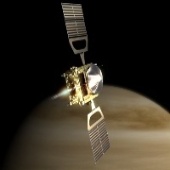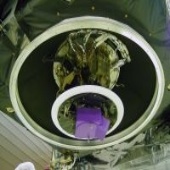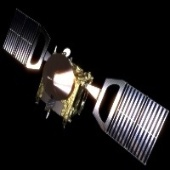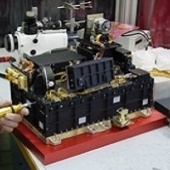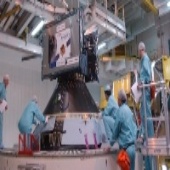ESA Science & Technology - Status Report Archive
Status report archive
Status report archive
The special issue of Space Science Reviews, "ISO science legacy - a compact review of ISO major achievements" (480 pages) has been published by Springer. The plan for the remaining ISO activities was agreed with the National Data Centres in October. Twenty Highly Processed Data Products projects are foreseen to be carried out in 2006.
Published: 15 February 2006
Mission Status All spacecraft subsystems are operating nominally. On 1 February 2006, Ulysses will be at a radial distance of 4.35 AU from the Sun, and heliographic latitude 40° south of the solar equator.
Published: 15 February 2006
Mission StatusFrom the operational point of view, the Hubble spacecraft is working nominally. Since the switch to two-gyro mode in late August 2005, operations have continued without any problems. The two-gyro mode operating well, work shifted to evaluating the potential for a one-gyro mode. An initial study confirmed its feasibility and work...
Published: 15 February 2006
Report for Period 03 February to 09 February 2006Operations during the reporting period have been moved again over the New Norcia station andspacecraft activities has focused on further TTC tests, characterisation of STRs acquisitionperformance, and Radio Science activities.
Published: 13 February 2006
Report for Period 27 January - 02 February 2006During the reporting period the Thermal Characterization Scenario with Sun illumination of the cryo face (-X) and the Main Engine face (+Z) has been completed. The MAG instrument hasbeen switched ON, the Star Tracker Stray Light Test has been performed, and a TM bit rate test with the Cebreros...
Published: 6 February 2006
Report for Period 20 January - 26 January 2006During the reporting period the last part of the payloads pointing scenario has been completedand the in-flight thermal characterisation has started. During this characterisation all cold facesof the spacecraft are exposed to a certain time to the Sun in order to fully validate the thermalmodel. This...
Published: 30 January 2006
Report for Period 6 January - 27 January 2006The reporting period covers three weeks of passive cruise, with monitoring and minor maintenance activities.On the subsystems side, the TC link timeout was returned to its normal value of 9 days on 12 January. The TM mode was temporarily changed to "bi-weekly" between 12 and 19 January, to...
Published: 30 January 2006
Report for period 19 December 2005 to 15 January 2006SMART-1 operation has been nominal during the Christmas period. The push-broom operations were terminated just before Christmas giving the pace for resuming routine payload operations. The only noticeable event was a glitch in the star tracker software that did not have any impact on operations.
Published: 24 January 2006
Report for Period 13 January - 19 January 2006 During the reporting period the spacecraft control has been switched back to the Cebrerosantenna. The period has been characterised by the second payload pointing campaign whichwill finish in the next reporting period.
Published: 24 January 2006
Report for Period 06 January - 12 January 2006During the reporting period the spacecraft has been monitored using the New Norcia antenna. The spacecraft has passed through a period of quasi inferior conjunction without any observable effects.
Published: 16 January 2006
Report for Period 16 December 2005 - 05 January 2006During the reporting period the spacecraft has been configured for a passive cruise phase andthe only activities conducted on top of the routine ones are the DDOR tests with ESA (NNO-CEB)and DSN (GDS-CAN) stations.
Published: 9 January 2006
Report for Period 9 December 2005 - 6 January 2006The reporting period covers four weeks of passive cruise, with monitoring and minor maintenance activities.On the subsystems side, the attitude guidance has been changed to +X Earth pointing on 14 December 2005, to reduce the disturbance torques experienced by the spacecraft and therefore the...
Published: 9 January 2006
Report for period 21 November to 18 December 2005Smart-1 push-broom operations have continued throughout the reporting period withoutinterruptions. The illumination of the +Y face of the S/C in last period of push broom operationsresulted in the highest peak temperatures ever measured in the star tracker cameras. All payloaddata could be dumped...
Published: 23 December 2005
Report for Period 09 December to 15 December 2005During the reporting period the last activities of the Near Earth Commissioning have beencompleted according to the plan. Two slots with the New Norcia ground station have beendedicated to test the performance of the TTC subsystem and of the Ultra Stable Oscillator(USO) for the radio science...
Published: 20 December 2005
Report for Period 18 November to 9 December 2005The reporting period covers three weeks of passive cruise, with monitoring and minor maintenance activities.On the spacecraft subsystems side, minor maintenance activities were executed, i.e. gyro drift compensation for IMP B, the first periodic dump of avionics standard parameters. Reaction wheel...
Published: 12 December 2005
Report for Period 02 December to 08 December 2005During the reporting period all the activities for the Near Earth Commissioning of theinstruments have been conducted according to the plan. The multi-instrument pointing scenarioactivities have been successfully concluded and the PFS instrument has been switched on forthe first time.
Published: 12 December 2005
Report for Period 25 November to 01 December 2005During the reporting period all the activities for the Near Earth Commissioning of theinstruments have been conducted according to plan. The SPICAV instrument has beensuccessfully switched ON for the first time.
Published: 5 December 2005
Report for period 17 October to 20 November 2005Scientific operations have continued without interruptions. The pointing constraints for Push-broom operations were reviewed in order to relax them and have additional opportunities. They wereimplemented during the reporting period without affecting on-going operations.
Published: 28 November 2005
Mission StatusA major solar flare starting on 8 September 2005 interrupted operations for three and a half revolutions, implying some 380 ksec of science time lost. The final switchover of the full ground segment from SCOS-1b to SCOS-2000 was made in June 2005. The ground segment has been successfully running on the new system since.
Published: 28 November 2005
OperationsThe Huygens Flight Operations activities are terminated and so the Huygens Probe Operations Center (HPOC) at ESOC is closing down. HPOC hardware and documentation will be shipped to ESTEC for respectively inventory and archiving.
Published: 28 November 2005
—
20 Items per Page



